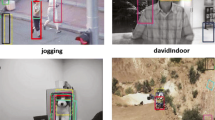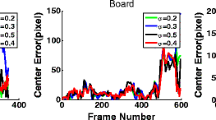Abstract
In this paper, we formulate object tracking in a particle filter framework as a structured multi-task sparse learning problem, which we denote as Structured Multi-Task Tracking (S-MTT). Since we model particles as linear combinations of dictionary templates that are updated dynamically, learning the representation of each particle is considered a single task in Multi-Task Tracking (MTT). By employing popular sparsity-inducing \(\ell _{p,q}\) mixed norms \((\text{ specifically} p\in \{2,\infty \}\) and \(q=1),\) we regularize the representation problem to enforce joint sparsity and learn the particle representations together. As compared to previous methods that handle particles independently, our results demonstrate that mining the interdependencies between particles improves tracking performance and overall computational complexity. Interestingly, we show that the popular \(L_1\) tracker (Mei and Ling, IEEE Trans Pattern Anal Mach Intel 33(11):2259–2272, 2011) is a special case of our MTT formulation (denoted as the \(L_{11}\) tracker) when \(p=q=1.\) Under the MTT framework, some of the tasks (particle representations) are often more closely related and more likely to share common relevant covariates than other tasks. Therefore, we extend the MTT framework to take into account pairwise structural correlations between particles (e.g. spatial smoothness of representation) and denote the novel framework as S-MTT. The problem of learning the regularized sparse representation in MTT and S-MTT can be solved efficiently using an Accelerated Proximal Gradient (APG) method that yields a sequence of closed form updates. As such, S-MTT and MTT are computationally attractive. We test our proposed approach on challenging sequences involving heavy occlusion, drastic illumination changes, and large pose variations. Experimental results show that S-MTT is much better than MTT, and both methods consistently outperform state-of-the-art trackers.





Similar content being viewed by others
Explore related subjects
Discover the latest articles, news and stories from top researchers in related subjects.Notes
The score is the ratio of the intersection to the union of two bounding boxes. In our case, it would be the ratio of the intersection of the ground truth and the predicted tracks to their union in each frame.
Since the degree matrix \(\hat{\mathbf{D }}\) is diagonal and non-negative and since the Laplacian \(\mathbf L \) of any graph is positive semi-definite, the normalized Laplacian \(\hat{\mathbf{L }}\) is positive semi-definite. Thus, \(G(\mathbf C )\) is convex in \(\mathbf C .\)
The proximal mapping of a non-smooth convex function \(h(.)\) is defined as: \(\mathbf{prox }_h(\mathbf x )=\arg \min _\mathbf{u }\left(h(\mathbf u )+\frac{1}{2}\Vert \mathbf u -\mathbf x \Vert _2^2\right).\)
This dissimilarity measure is used often to compare tracking performance. Other measures can be used, including the PASCAL overlap score.
References
Adam, A., Rivlin, E.,& Shimshoni, I. (2006). Robust fragments-based tracking using the integral histogram. In IEEE conference on computer vision and pattern recognition (pp. 798–805).
Avidan, S. (2005). Ensemble tracking. In IEEE conference on computer vision and pattern recognition (pp. 494–501).
Babenko, B., Yang, M. H.,& Belongie, S. (2009). Visual tracking with online multiple instance learning. In IEEE conference on computer vision and pattern recognition (pp. 983–990).
Bao, C., Wu, Y., Ling, H.,& Ji, H. (2012). Real time robust l1 tracker using accelerated proximal gradient approach. In IEEE conference on computer vision and pattern recognition (pp. 1–8).
Beck, A.,& Teboulle, M. (2009). A fast iterative shrinkagethresholding algorithm for linear inverse problems. SIAM Journal on Imaging Science, 2(1), 183–202.
Black, M. J.,& Jepson, A. D. (1998). Eigentracking: Robust matching and tracking of articulated objects using a view-based representation. International Journal of Computer Vision, 26(1), 63–84.
Blasch, E.,& Kahler, B. (2005). Multiresolution EO/IR target tracking and identification. In International conference on information fusion (Vol. 8, pp. 1–8).
Candès, E. J., Romberg, J. K.,& Tao, T. (2006). Stable signal recovery from incomplete and inaccurate measurements. Communications on Pure and Applied Mathematics, 59(8), 1207–1223.
Chen, X., Pan, W., Kwok, J.,& Carbonell, J. (2009). Accelerated gradient method for multi-task sparse learning problem. In IEEE international conference on data mining (pp. 746–751).
Collins, R. T.,& Liu, Y. (2003). On-line selection of discriminative tracking features. In International conference on computer vision (pp. 346–352).
Comaniciu, D., Ramesh, V.,& Meer, P. (2003). Kernel-based object tracking. IEEE Transactions on Pattern Analysis and Machine Intelligence, 25(5), 564–575.
Doucet, A., De Freitas, N.,& Gordon, N. (2001). Sequential Monte Carlo methods in practice (1st ed.). Springer.
Grabner, H., Grabner, M.,& Bischof, H. (2006). Real-time tracking via on-line boosting. In British machine vision conference (pp. 1–10).
Grabner, H., Leistner, C.,& Bischof, H. (2008). Semi-supervised on-line boosting for robust tracking. In European conference on computer vision (pp. 234–247).
Isard, M.,& Blake, A. (1998). Condensation—Conditional density propagation for visual tracking. International Journal of Computer Vision, 29(1), 5–28.
Jepson, A., Fleet, D.,& El-Maraghi, T. (2003). Robust on-line appearance models for visual tracking. IEEE Transactions on Pattern Analysis and Machine Intelligence, 25(10), 1296–1311.
Jiang, N., Liu, W.,& Wu, Y. (2011). Adaptive and discriminative metric differential tracking. In IEEE conference on computer vision and pattern recognition (pp. 1161–1168).
Khan, Z., Balch, T.,& Dellaert, F. (2004). A rao-blackwellized particle filter for eigentracking. In IEEE conference on computer vision and pattern recognition (pp. 980–986).
Kwon, J.,& Lee, K. M. (2010). Visual tracking decomposition. In IEEE conference on computer vision and pattern recognition (pp. 1269–1276).
Leistner, C., Godec, M., Saffari, A.,& Bischof, H. (2010). Online multi-view forests for tracking. In DAGM (pp. 493–502).
Li, H., Shen, C.,& Shi, Q. (2011). Real-time visual tracking with compressed sensing. In IEEE conference on computer vision and pattern recognition (pp. 1305–1312).
Liu, B., Huang, J., Yang, L.,& Kulikowski, C. (2011). Robust visual tracking with local sparse appearance model and k-selection. In IEEE conference on computer vision and pattern recognition (pp. 1–8).
Liu, B., Yang, L., Huang, J., Meer, P., Gong, L.,& Kulikowski, C. (2010). Robust and fast collaborative tracking with two stage sparse optimization. In European conference on computer vision (pp. 1–14).
Liu, R., Cheng, J.,& Lu, H. (2009). A robust boosting tracker with minimum error bound in a co-training framework. In International conference on computer vision (pp. 1459–1466).
Mei, X.,& Ling, H. (2011). Robust visual tracking and vehicle classification via sparse representation. IEEE Transactions on Pattern Analysis and Machine Intelligence, 33(11), 2259–2272.
Mei, X., Ling, H., Wu, Y., Blasch, E.,& Bai, L. (2011). Minimum error bounded efficient l1 tracker with occlusion detection. In IEEE conference on computer vision and pattern recognition (pp. 1257–1264).
Nesterov, Y. (2007). Gradient methods for minimizing composite objective function. In CORE discussion paper.
Peng, Y., Ganesh, A., Wright, J., Xu, W.,& Ma, Y. (2012). RASL: Robust alignment by sparse and low-rank decomposition for linearly correlated images. IEEE Transactions on Pattern Analysis and Machine Intelligence, 34, 2233–2246.
Quattoni, A., Carreras, X., Collins, M.,& Darrell, T. (2009). An efficient projection for l 1, infinity regularization. In International conference on machine learning (pp. 857–864).
Ross, D., Lim, J., Lin, R. S.,& Yang, M. H. (2008). Incremental learning for robust visual tracking. International Journal of Computer Vision, 77(1), 125–141.
Tseng, P. (2008). On accelerated proximal gradient methods for convex–concave optimization. Technical report. http://pages.cs.wisc.edu/~brecht/cs726docs/Tseng.APG.pdf.
Wu, Y.,& Huang, T. S. (2004). Robust visual tracking by integrating multiple cues based on co-inference learning. International Journal of Computer Vision, 58, 55–71.
Yang, C., Duraiswami, R.,& Davis, L. (2005). Fast multiple object tracking via a hierarchical particle filter. In International conference on computer vision (pp. 212–219).
Yang, M., Wu, Y.,& Hua, G. (2009). Context-aware visual tracking. IEEE Transactions on Pattern Analysis and Machine Intelligence, 31(7), 1195–1209.
Yilmaz, A., Javed, O.,& Shah, M. (2006). Object tracking: A survey. ACM Computing Surveys, 38(4), 13.
Yin, Z.,& Collins, R. (2008). Object tracking and detection after occlusion via numerical hybrid local and global mode-seeking. In IEEE conference on computer vision and pattern recognition (pp. 1–8).
Yu, Q., Dinh, T. B.,& Medioni, G. (2008). Online tracking and reacquisition using co-trained generative and discriminative trackers. In European conference on computer vision (pp. 678–691).
Yuan, X.,& Yan, S. (2010). Visual classification with multi-task joint sparse representation. In IEEE conference on computer vision and pattern recognition (pp. 3493–3500).
Zhang, T., Ghanem, B., Liu, S.,& Ahuja, N. (2012a). Low-rank sparse learning for robust visual tracking. In European conference on computer vision (pp. 1–8).
Zhang, T., Ghanem, B., Liu, S.,& Ahuja, N. (2012b). Robust visual tracking via multi-task sparse learning. In IEEE conference on computer vision and pattern recognition (pp. 1–8).
Zhou, S. K., Chellappa, R.,& Moghaddam, B. (2004). Visual tracking and recognition using appearance-adaptive models in particle filters. IEEE Transactions on Image Processing, 11(1), 1491–1506.
Zhu, X. (2008). Semi-supervised learning literature survey. Computer sciences technical report 1530, University of Madison.
Acknowledgments
This study is supported by the research grant for the Human Sixth Sense Programme at the Advanced Digital Sciences Center from Singapore’s Agency for Science, Technology and Research (A\(^*\)STAR).
Author information
Authors and Affiliations
Corresponding author
Electronic supplementary material
Below is the link to the electronic supplementary material.
Rights and permissions
About this article
Cite this article
Zhang, T., Ghanem, B., Liu, S. et al. Robust Visual Tracking via Structured Multi-Task Sparse Learning. Int J Comput Vis 101, 367–383 (2013). https://doi.org/10.1007/s11263-012-0582-z
Received:
Accepted:
Published:
Issue Date:
DOI: https://doi.org/10.1007/s11263-012-0582-z




